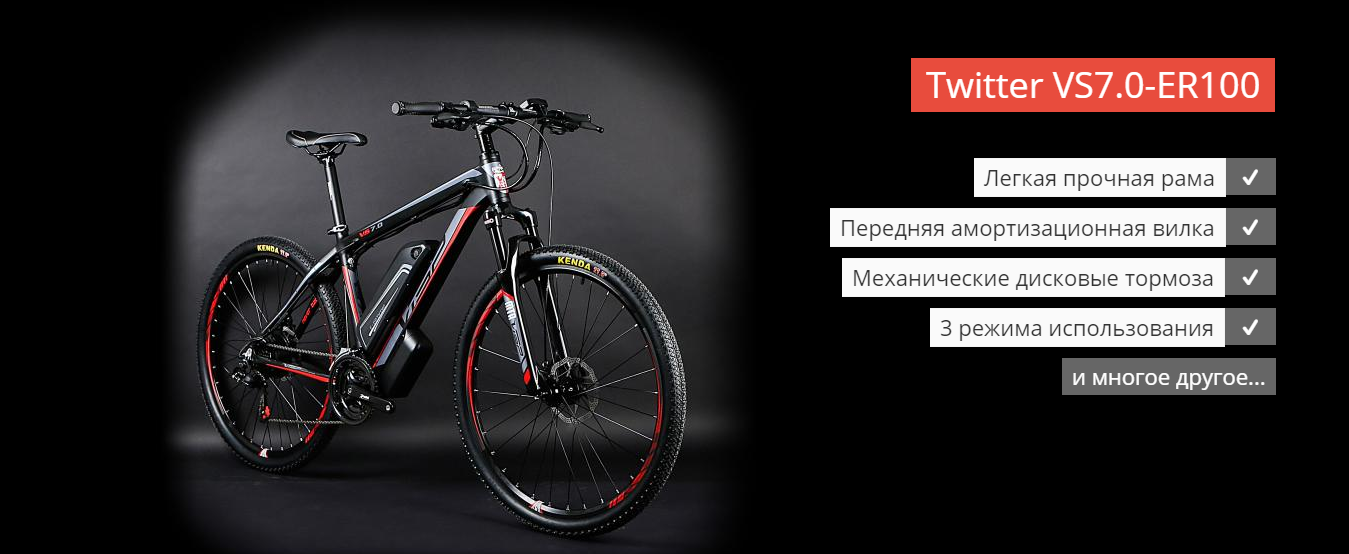Guide: how to choose an electric bike using Twitter as an example - talking about frames
We talk about veloramas - the materials from which they are made, and form factors. Image: Gemma Evans / Unsplash

The material of the frame affects the price of the bike and its characteristics: appearance, weight, strength. The most commonly used are steel, aluminum, titanium and carbon.
Steel frames began to be used at the end of the 19th century . Bicycles with such frames are durable but heavy. Gradually, steel began to supplant other, more lightweight materials - aluminum and carbon. However, steel frames have not disappeared completely and are still found.
Most often, manufacturers use two types of steel: carbon steel (Hi-Ten) and chromium-molybdenum alloy (Cro-Moly). Carbon steel is one of the simplest and cheapest materials. It does not contain alloying additives and is found on entry-level bikes. Cro-Moly has molybdenum, it gives the steel a fine-grained structure and increases strength.
Pros:The main advantage of a steel frame is durability. It is difficult to bend when bumped or dropped. Such a frame rarely breaks suddenly - cracks that have appeared for any reason develop gradually, making themselves felt squeaky. If a breakdown does occur, the steel structure is easy to repair. In some cases, bent pipes can be straightened, and cracked seams can be digested. Steel is mainly used to make entry-level bicycles and utilitarian devices on which goods can be transported.
Minuses:As we already said, steel is heavier than other materials - the difference in weight can reach a kilogram. For example, the weight of the steel frame is closely matched to two kilograms, while the carbon frame (which we will talk about later) can be lighter than 950 grams. Manufacturers use technologies designed to facilitate the steel frame of the bicycle, for example butting (the structure is assembled from pipes with variable geometry).
Another disadvantage of steel is its susceptibility to corrosion. If you don’t take care of such a frame, then rust can appear rather quickly in the places of chips (where the paintwork is damaged).
Aluminum frames are the most popular type in modern industry. Two alloys are used - 6061 and 7005. The first contains impurities of copper and iron, which makes it more pliable. As a result, the production of a frame from 6061 is cheaper. The main alloying elements of the second alloy are zinc and magnesium, so it is more resistant to stress and shock.
Pros: The main advantages of aluminum are that it is lighter than steel and better resists corrosion. Upon contact with oxygen, an oxide film appears on it, which protects the metal from rust. However, if this protective layer is nevertheless broken (a scratch and even the salt used to sprinkle the roads can do this), then aluminum will begin to corrode.
Aluminum frames are relatively affordable. For example, the price of a Twitter VS7.0-ER100 electric bike with an aluminum frame is 54 thousand rubles. The carbon TW-E9L carbon model will cost 150 thousand. Of course, the difference in attachments should be taken into account, but the general trend is clear.

In the photo: Twitter VS7.0-ER100
Cons:Aluminum "gets tired" over time, especially if there are dents on its surface. Some cyclists recommend regularly checking the condition of the deformed aluminum frame and, if possible, not delaying its replacement. To increase the structural strength, manufacturers, as in the case of steel, use butting (double or triple), but this leads to a rise in the cost of the frame.
Repairing an aluminum frame is also not an easy process. Due to the chemical characteristics of the material, it is difficult to cook. Aluminum has a high coefficient of linear expansion ; therefore, it deforms strongly when heated.
Such a frame is lighter than steel, but heavier than aluminum. By strength, it also appears somewhere in the middle.
Pros: It is believed that a titanium frame is a frame for life. It is resistant to damage, practically does not wear out and does not corrode. Such frames are often left unpainted. Titanium absorbs high-frequency vibrations well when riding on an uneven surface, so bicycles with a frame made of this material are considered more comfortable.
Cons: Manufacturing a titanium frame is a difficult process. Tools during pipe cutting wear out quickly (due to the hardness of the alloy), and special conditions are required for titanium cooking. These features adversely affect the cost of the frame - it is two times more expensive than steel or aluminum.
Carbon began to gain popularity (as a material for frames) at the dawn of the 90s. Then professional cyclists began to use it for obvious reasons (carbon frames were much lighter than the steel ones popular at that time). In 1999, American road racing cyclist Lance Armstrong won the Tour de France on a Trek bike. This was the first time that a rider traveled the entire route on a carbon bike.

Image: Markus Spiske / Unsplash
The high cost and sophisticated production methods prevented the widespread adoption of carbon frames. Special fabrics made of carbon filaments are layered in layers, each time changing the angle of the direction of weaving to give strength. Then the layers are bonded with epoxy resins. Initially, this process was absolutely not automated. Over time, technological processes have improved, but manual labor is still used in the production of carbon frames .
Pros: The main advantage of carbon fiber is lightness. For comparison, the Twitter line has two carbon-fiber electric bikes TW-E9L and E9W - their weight is 18 kilograms (taking into account the weight of the battery). While the weight of electric bikes with an aluminum frame reaches 20 kilograms .
It is easy to give carbon to any shape, which opens up great opportunities for designers. Hence its popularity in the production of custom bikes. Custom bureaus like Filament Bikes or Argonaut Cycles are creating custom carbon frames.
Cons: In addition to the high cost, among the shortcomings can be noted fragility. If the integrity of the carbon fiber is compromised, the frame may break at any time. And in most cases, broken carbon frames are not repairable - they have to be replaced entirely.
On the network you can find a site - Busted Carbon - the author of which uploaded photographs of suddenly cracked carbon frames sent by readers. There is a similar thread on Reddit .
The rigid frame has a rigid front fork and does not have a rear suspension. The first prototypes of modern bicycles had just such a design. An example of a modern rigid bike is the Airwheel R8 - its frame and front fork are made of high-strength aluminum pipe.

In the photo: Airwheel R8
Pros: Low weight - a steel rigid fork weighs one and a half kilograms, an aluminum fork is about one kilogram, the weight of a carbon one is even less. The weight of a fork with shock absorption approaches two kilograms.
Cons: Strong steering wheel vibration - at high speed when hit in pits or potholes, there is a chance of losing control of the bike. Experts note that you can increase driving comfort by installing a carbon steering wheel. It will dampen vibrations. A thick tire with a width of 2.3 inches will also help.
This is a bike with a solid frame, but with a front suspension. Perhaps the most common type of bike today.
Pros: An amortized fork softens small tremors, it is more comfortable to ride with it. At the same time, a hardtail-type frame still has a rather simple design, which increases reliability.
Cons: Although this type of frame is suitable for cross-country driving, the ride can be tough. We tested the Twitter TW-E9L electric bike with a hardtail in off-road conditions and even conducted a small crash test .
The bike showed its best side. However, to ride a hardtail type bike along the “intersection” you have to stand for the most part - the lack of a rear shock absorber affects it.
Bicycles with two shock absorbers - front and rear - are designed to overcome rocky tracks and steep descents. Such bikes are used by professional athletes in downhill competitions . However, riding a city on such a bicycle also has its advantages.
Pluses: Depreciation of both wheels completely eliminates small tremors, while large ones significantly softens. For this reason, it becomes comfortable to ride on any surface (including on asphalt).
Cons: Strong buildup from pedaling, which takes away most of the muscle energy - it becomes more difficult to ride.
The second problem is the weight of the bike. A two-pendant aluminum electric bike weighing 20 kilograms is quite normal. For bicycles without an electric motor, this figure is slightly less - there are models weighing 18 or 19 kilograms.
Next time we will continue to talk about the components of electric bikes: types of engines, batteries, pedals and body kits.
Twitter Bicycle Reviews:

Material
The material of the frame affects the price of the bike and its characteristics: appearance, weight, strength. The most commonly used are steel, aluminum, titanium and carbon.
Steel
Steel frames began to be used at the end of the 19th century . Bicycles with such frames are durable but heavy. Gradually, steel began to supplant other, more lightweight materials - aluminum and carbon. However, steel frames have not disappeared completely and are still found.
Most often, manufacturers use two types of steel: carbon steel (Hi-Ten) and chromium-molybdenum alloy (Cro-Moly). Carbon steel is one of the simplest and cheapest materials. It does not contain alloying additives and is found on entry-level bikes. Cro-Moly has molybdenum, it gives the steel a fine-grained structure and increases strength.
Pros:The main advantage of a steel frame is durability. It is difficult to bend when bumped or dropped. Such a frame rarely breaks suddenly - cracks that have appeared for any reason develop gradually, making themselves felt squeaky. If a breakdown does occur, the steel structure is easy to repair. In some cases, bent pipes can be straightened, and cracked seams can be digested. Steel is mainly used to make entry-level bicycles and utilitarian devices on which goods can be transported.
Minuses:As we already said, steel is heavier than other materials - the difference in weight can reach a kilogram. For example, the weight of the steel frame is closely matched to two kilograms, while the carbon frame (which we will talk about later) can be lighter than 950 grams. Manufacturers use technologies designed to facilitate the steel frame of the bicycle, for example butting (the structure is assembled from pipes with variable geometry).
Interestingly, not so long ago, attempts were made to return steel frames to the professional arena. The English Madison-Genesis team, last year’s winner of the UK National Road Cycling Championship, used Volare steel bikes several years ago during the competition.
However, the steel frame still lost in weight to structures made of other materials. In the end, the team returned to carbon.
Another disadvantage of steel is its susceptibility to corrosion. If you don’t take care of such a frame, then rust can appear rather quickly in the places of chips (where the paintwork is damaged).
Aluminum alloys
Aluminum frames are the most popular type in modern industry. Two alloys are used - 6061 and 7005. The first contains impurities of copper and iron, which makes it more pliable. As a result, the production of a frame from 6061 is cheaper. The main alloying elements of the second alloy are zinc and magnesium, so it is more resistant to stress and shock.
Western aluminum cyclists called early aluminum frames "cotton" (noodly). They were built from pipes of the same diameter as steel pipes. The change in the stiffness of the material was not taken into account, so the frames bent and “played” when driving.
Modern aluminum bikes have large pipes - the difference compared with steel can reach 20-30%.
Pros: The main advantages of aluminum are that it is lighter than steel and better resists corrosion. Upon contact with oxygen, an oxide film appears on it, which protects the metal from rust. However, if this protective layer is nevertheless broken (a scratch and even the salt used to sprinkle the roads can do this), then aluminum will begin to corrode.
Aluminum frames are relatively affordable. For example, the price of a Twitter VS7.0-ER100 electric bike with an aluminum frame is 54 thousand rubles. The carbon TW-E9L carbon model will cost 150 thousand. Of course, the difference in attachments should be taken into account, but the general trend is clear.

In the photo: Twitter VS7.0-ER100
Cons:Aluminum "gets tired" over time, especially if there are dents on its surface. Some cyclists recommend regularly checking the condition of the deformed aluminum frame and, if possible, not delaying its replacement. To increase the structural strength, manufacturers, as in the case of steel, use butting (double or triple), but this leads to a rise in the cost of the frame.
Repairing an aluminum frame is also not an easy process. Due to the chemical characteristics of the material, it is difficult to cook. Aluminum has a high coefficient of linear expansion ; therefore, it deforms strongly when heated.
Titanium alloys
Such a frame is lighter than steel, but heavier than aluminum. By strength, it also appears somewhere in the middle.
Pros: It is believed that a titanium frame is a frame for life. It is resistant to damage, practically does not wear out and does not corrode. Such frames are often left unpainted. Titanium absorbs high-frequency vibrations well when riding on an uneven surface, so bicycles with a frame made of this material are considered more comfortable.
Cons: Manufacturing a titanium frame is a difficult process. Tools during pipe cutting wear out quickly (due to the hardness of the alloy), and special conditions are required for titanium cooking. These features adversely affect the cost of the frame - it is two times more expensive than steel or aluminum.
Carbon
Carbon began to gain popularity (as a material for frames) at the dawn of the 90s. Then professional cyclists began to use it for obvious reasons (carbon frames were much lighter than the steel ones popular at that time). In 1999, American road racing cyclist Lance Armstrong won the Tour de France on a Trek bike. This was the first time that a rider traveled the entire route on a carbon bike.

Image: Markus Spiske / Unsplash
The high cost and sophisticated production methods prevented the widespread adoption of carbon frames. Special fabrics made of carbon filaments are layered in layers, each time changing the angle of the direction of weaving to give strength. Then the layers are bonded with epoxy resins. Initially, this process was absolutely not automated. Over time, technological processes have improved, but manual labor is still used in the production of carbon frames .
Pros: The main advantage of carbon fiber is lightness. For comparison, the Twitter line has two carbon-fiber electric bikes TW-E9L and E9W - their weight is 18 kilograms (taking into account the weight of the battery). While the weight of electric bikes with an aluminum frame reaches 20 kilograms .
It is easy to give carbon to any shape, which opens up great opportunities for designers. Hence its popularity in the production of custom bikes. Custom bureaus like Filament Bikes or Argonaut Cycles are creating custom carbon frames.
Cons: In addition to the high cost, among the shortcomings can be noted fragility. If the integrity of the carbon fiber is compromised, the frame may break at any time. And in most cases, broken carbon frames are not repairable - they have to be replaced entirely.
On the network you can find a site - Busted Carbon - the author of which uploaded photographs of suddenly cracked carbon frames sent by readers. There is a similar thread on Reddit .
Form factor
Rigid
The rigid frame has a rigid front fork and does not have a rear suspension. The first prototypes of modern bicycles had just such a design. An example of a modern rigid bike is the Airwheel R8 - its frame and front fork are made of high-strength aluminum pipe.

In the photo: Airwheel R8
Pros: Low weight - a steel rigid fork weighs one and a half kilograms, an aluminum fork is about one kilogram, the weight of a carbon one is even less. The weight of a fork with shock absorption approaches two kilograms.
It is easier to ride with a rigid fork, since the energy from pedaling goes directly to the wheels (it is not spent on depreciation). Serving such forks is also not necessary: they have nothing to lubricate and clean. Plus, the rigid structure does not have moving components, which reduces the risk of breakage.
Cons: Strong steering wheel vibration - at high speed when hit in pits or potholes, there is a chance of losing control of the bike. Experts note that you can increase driving comfort by installing a carbon steering wheel. It will dampen vibrations. A thick tire with a width of 2.3 inches will also help.
Hardtail
This is a bike with a solid frame, but with a front suspension. Perhaps the most common type of bike today.
Pros: An amortized fork softens small tremors, it is more comfortable to ride with it. At the same time, a hardtail-type frame still has a rather simple design, which increases reliability.
Cons: Although this type of frame is suitable for cross-country driving, the ride can be tough. We tested the Twitter TW-E9L electric bike with a hardtail in off-road conditions and even conducted a small crash test .
The bike showed its best side. However, to ride a hardtail type bike along the “intersection” you have to stand for the most part - the lack of a rear shock absorber affects it.
Two-hanging
Bicycles with two shock absorbers - front and rear - are designed to overcome rocky tracks and steep descents. Such bikes are used by professional athletes in downhill competitions . However, riding a city on such a bicycle also has its advantages.
Pluses: Depreciation of both wheels completely eliminates small tremors, while large ones significantly softens. For this reason, it becomes comfortable to ride on any surface (including on asphalt).
Cons: Strong buildup from pedaling, which takes away most of the muscle energy - it becomes more difficult to ride.
There are systems that block shock absorbers until they are needed. The inertia valve responds to shock and unlocks the suspension.
As soon as the road becomes even again, shock absorbers are blocked. But such solutions are not cheap and require regular maintenance. Therefore, they are used mainly by athletes.
The second problem is the weight of the bike. A two-pendant aluminum electric bike weighing 20 kilograms is quite normal. For bicycles without an electric motor, this figure is slightly less - there are models weighing 18 or 19 kilograms.
Next time we will continue to talk about the components of electric bikes: types of engines, batteries, pedals and body kits.
Twitter Bicycle Reviews:
